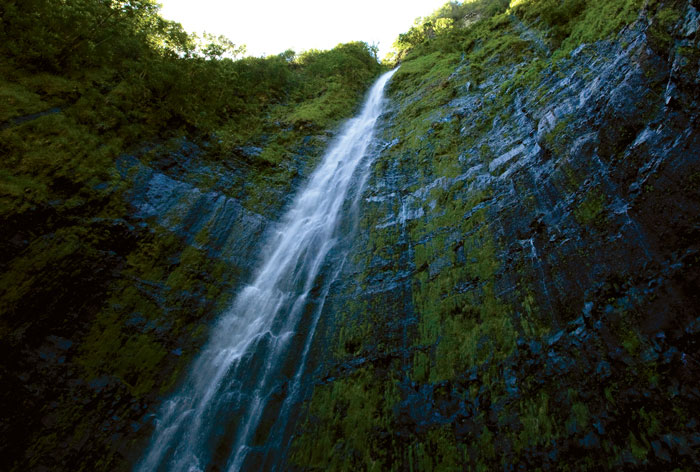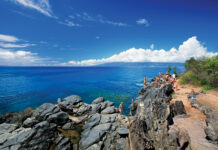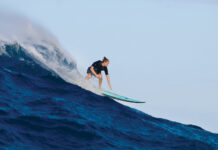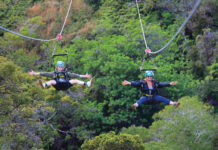Story by Sky Barnhart | Photography by Bob Bangerter
 Outside the Kipahulu visitors’ center, the Hawaiian word of the day posted on a sign is Kauanoe, misty rain. No such luck this morning, although there is a pleasant cloud cover.
Outside the Kipahulu visitors’ center, the Hawaiian word of the day posted on a sign is Kauanoe, misty rain. No such luck this morning, although there is a pleasant cloud cover.
Looking around the quiet center, I ask if there is an orientation, and get a better answer than I expected: “I could head up with you if you want,” offers Park guide Jackie Frost.
I warn her that Steve and I might be slow hikers with the baby in tow, and off we start. Hidden beneath long sleeves, pants and hat, the baby is quickly lulled to sleep on my back.
We skirt the main parking lot, where heavy equipment and piles of blue rock foretell changes to come: a three-tiered parking facility, flush toilets and an expanded visitor center due to be completed by year’s end.
Other changes are apparent since we hiked the trail two years ago, thanks to economic and natural conditions. The parking lot, once packed with cars, is relatively empty at nine a.m. Puffs of dust spring up from our footfalls, and the grass is dry along the roadside as we cross the highway to the trailhead. “We haven’t had a good rain since mid-April,” Frost tells me.
She says she has worked here for seven years and hikes the trail at least once a week. I ask her if people are finally moving away from the “Seven Sacred Pools” misnomer. Somewhat, she says. In reality, there are twenty-four pools slipping down beautiful ‘Ohe‘o Gulch.
The trail we start up is called Pipiwai or “sparkling waters.” It’s two miles long, (four round-trip), and in the first mile, we gain 800 feet in elevation.
A sign warns of “flash floods, slippery rocks and swift currents.” Not too likely today, although the last time I hiked this trail, the sign was ominously accurate. That was after Maui’s infamous “forty days of rain,” when the falls were gushing and the rocks felt like they’d been greased with suntan oil.
Today, the same rocks are dusty underfoot. Diamond-shaped red and yellow leaves are strewn like gems across the trail.
We stop to look at the concrete remains of an old sugarcane flume. Once, Kipahulu was a thriving ahupua‘a (traditional Hawaiian land division) planted with kalo (taro). Later came sugarcane, which lined both sides of ‘Ohe‘o Stream until the 1920s.
A half-mile up, we come to Makahiku Overlook, where a lava-rock wall frames the view across the gulch. The 184-foot falls are dry.
On we go, beneath mango trees dotted with small, hard, green fruit; through a metal gate—a remnant of days when cattle roamed the area—ducking under the roots of a huge banyan tree.
Birds are singing; Frost identifies one as a melodious thrush. Then an unwelcome sound: the thin buzz of mosquitoes. Slapping my legs, I’m glad the baby is well covered.
We forget the mosquitoes when we see the first bridge spanning ‘Ohe‘o Stream—the idyllic setting of many a postcard. Standing in the middle, we look up to the second bridge and the place where ‘Ohe‘o Stream is formed from the merging of two smaller streams, Palikea and Pipiwai.
Last time I was here, the stream was a tumbling torrent, carving the walls with its fury. Today, I drop a guava leaf over the side and watch it spin down and settle onto the water’s glassy surface. Clouds move overhead, and the bridge sways slightly as a couple passes us.
Across the bridge, the scenery changes. Under bamboo cover, we tread carefully on wet, black stones. Sodden bamboo leaves are piled along the sides of the trail. Frost points out huge birds’ nest ferns tucked into the trees.
Across the second bridge, the air is hushed and cool, and the stone steps curve upward between feathery bamboo towers. The smooth, shiny green stalks creak and clack together in the breeze. Drops of moisture fall onto my arms.
There is history in the crisscrossing shadows and the hollow symphony stirred by the wind. Back when sugar was king, Chinese and Japanese laborers planted bamboo brought from their homelands and built their houses with it.
“The local people still come to the forest to harvest bamboo shoots,” Frost tells us. Since bamboo is invasive, we don’t feel bad when Frost finds a tender shoot and gives it a swift kick. It pops over easily, and she shows us how to peel away the hairy outer stalks that quickly turn your hands purple. Boiled and soaked to remove the bitterness, the shoots make an ono stir-fry.
As we continue along the walkway, the forest thickens until we can no longer see the sky. Now I understand why the park discourages hikers from starting after three p.m. The darkness would be absolute.
Past the bamboo, African tulip trees spread above us, their big orange blossoms creating bright dots in the tree canopy.
Then suddenly, we’ve gone back in time. Cultivated terraces of dryland kalo appear on the bank, their heart-shaped leaves nestled within ancient rock walls. “Some of the Park staff are clearing away the vegetation and restoring what was here,” Frost says.
Coming around a bend amongst tall, skinny ti plants, we suddenly see a thin white waterfall spilling from the highest cliff above the tree line—400-foot-high Waimoku Falls.
I approach the wide stream gingerly. “We tell people not to cross if the water is above your knees,” Frost says. Today it’s barely up to our ankles—“about as easy as it gets,” she says. I splash through the shallows, the water deliciously cool on my feet.
Another few yards to the “Danger, Don’t Go Beyond This Point” sign, and we’re there, heads tilted back to gawk at the sheer height of the falls pouring down the lava rock wall. Bubbling from a natural spring, this is one waterfall that never goes dry, although today it’s thin enough to split in two against the rock face.
The walls wrap around us like an amphitheater, slick and shiny with water, crevices dotted with ferns and moss amongst the tiny rivulets. Rocks falling from such a height will explode on impact, which is why people are warned not to get under the falls.
Of course, they still do. After Frost takes her leave and starts back down the trail, I watch a young couple plunge into the pool, their voices echoing off the cliff wall.
Steve digs a crumbly lump of Hana banana bread out of the backpack, and we wash it down with swigs of water. The sun comes out brilliantly, tipping the grasses with a yellow glow.
Heading back down the trail, Steve hoists the baby onto his back. I walk behind them, light as air.
If you go
The trail to Waimoku Falls begins in Kipahulu, ten miles past Hana, and takes two-and-a-half to four hours roundtrip. Allow yourself time. We drove into Hana the day before so we’d have a fresh, early start.
The hike is inside Haleakala National Park; there’s a $10 entrance fee.
Bring plenty of water, a hat, sun screen and mosquito repellent.
Wear sturdy shoes, and be careful crossing streams.
Don’t begin the hike late in the day, or if it’s been raining heavily. Monitor weather conditions, and heed all posted warning signs.





